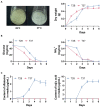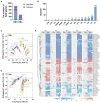Integrated metabolomics and lipidomics analyses suggest the temperature-dependent lipid desaturation promotes aflatoxin biosynthesis in Aspergillus flavus
- PMID: 37065116
- PMCID: PMC10102665
- DOI: 10.3389/fmicb.2023.1137643
Integrated metabolomics and lipidomics analyses suggest the temperature-dependent lipid desaturation promotes aflatoxin biosynthesis in Aspergillus flavus
Abstract
Temperature is one of the main factors affecting aflatoxin (AF) biosynthesis in Aspergillus flavus. Previous studies showed that AF biosynthesis is elevated in A. flavus at temperatures between 28°C-30°C, while it is inhibited at temperatures above 30°C. However, little is known about the metabolic mechanism underlying temperature-regulated AF biosynthesis. In this study, we integrated metabolomic and lipidomic analyses to investigate the endogenous metabolism of A. flavus across 6 days of mycelia growth at 28°C (optimal AF production) and 37°C (no AF production). Results showed that both metabolite and lipid profiles were significantly altered at different temperatures. In particular, metabolites involved in carbohydrate and amino acid metabolism were up-regulated at 37°C on the second day but down-regulated from days three to six. Moreover, lipidomics and targeted fatty acids analyses of mycelia samples revealed a distinct pattern of lipid species and free fatty acids desaturation. High degrees of polyunsaturation of most lipid species at 28°C were positively correlated with AF production. These results provide new insights into the underlying metabolic changes in A. flavus under temperature stress.
Keywords: Aspergillus flavus; aflatoxins; lipidomics; metabolomics; temperature.
Copyright © 2023 Wu, Huang, Wang, Zou, Li, Liu, Zhang and Yan.
Conflict of interest statement
The authors declare that the research was conducted in the absence of any commercial or financial relationships that could be construed as a potential conflict of interest.
Figures





Similar articles
-
Differential regulation of mycelial growth and aflatoxin biosynthesis by Aspergillus flavus under different temperatures as revealed by strand-specific RNA-Seq.Microbiologyopen. 2019 Oct;8(10):e897. doi: 10.1002/mbo3.897. Epub 2019 Jul 22. Microbiologyopen. 2019. PMID: 31328901 Free PMC article.
-
Suppression of Aflatoxin Biosynthesis in Aspergillus flavus by 2-Phenylethanol Is Associated with Stimulated Growth and Decreased Degradation of Branched-Chain Amino Acids.Toxins (Basel). 2015 Sep 24;7(10):3887-902. doi: 10.3390/toxins7103887. Toxins (Basel). 2015. PMID: 26404375 Free PMC article.
-
Comparison of aflatoxin production of Aspergillus flavus at different temperatures and media: Proteome analysis based on TMT.Int J Food Microbiol. 2019 Nov 16;310:108313. doi: 10.1016/j.ijfoodmicro.2019.108313. Epub 2019 Aug 24. Int J Food Microbiol. 2019. PMID: 31476580
-
Carbohydrate, glutathione, and polyamine metabolism are central to Aspergillus flavus oxidative stress responses over time.BMC Microbiol. 2019 Sep 5;19(1):209. doi: 10.1186/s12866-019-1580-x. BMC Microbiol. 2019. PMID: 31488075 Free PMC article.
-
Updates on the Functions and Molecular Mechanisms of the Genes Involved in Aspergillus flavus Development and Biosynthesis of Aflatoxins.J Fungi (Basel). 2021 Aug 17;7(8):666. doi: 10.3390/jof7080666. J Fungi (Basel). 2021. PMID: 34436205 Free PMC article. Review.
Cited by
-
Structure-guided discovery of novel AflG inhibitors for aflatoxin contamination control in aspergillus flavus.Front Microbiol. 2024 Jul 12;15:1425790. doi: 10.3389/fmicb.2024.1425790. eCollection 2024. Front Microbiol. 2024. PMID: 39070265 Free PMC article.
References
-
- Almeida M., Ambrogini E., Han L., Manolagas S. C., Jilka R. L. (2009). Increased lipid oxidation causes oxidative stress, increased peroxisome proliferator-activated receptor-gamma expression, and diminished pro-osteogenic Wnt signaling in the skeleton. J. Biol. Chem. 284, 27438–27448. doi: 10.1074/jbc.M109.023572, PMID: - DOI - PMC - PubMed
-
- Avila C., Pelissari C., Sezerino P. H., Sgroi M., Roccaro P., Garcia J. (2017). Enhancement of total nitrogen removal through effluent recirculation and fate of PPCPs in a hybrid constructed wetland system treating urban wastewater. Sci. Total Environ. 584-585, 414–425. doi: 10.1016/j.scitotenv.2017.01.024, PMID: - DOI - PubMed
-
- Bai Y., Wang S., Zhong H., Yang Q., Zhang F., Zhuang Z., et al. . (2015). Integrative analyses reveal transcriptome-proteome correlation in biological pathways and secondary metabolism clusters in a. flavus in response to temperature. Sci. Rep. 5:14582. doi: 10.1038/srep14582, PMID: - DOI - PMC - PubMed
-
- Bircan C. (2006). Determination of aflatoxin contamination in olives by immunoaffinity column using high-performance liquid chromatography. J Food Quality 29, 126–138. doi: 10.1111/j.1745-4557.2006.00061.x - DOI
LinkOut - more resources
Full Text Sources

